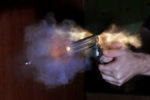OUTLINE
1.Legal bases.
2.Scope of Forensic Psychology.
3.Auxiliary sciences.
4.Intervention – Types of psychological intervention.
5.Battery of tests and interpretation.
6.Criminal psychology.
7.Psychological aspects of antisocial or delinquent behaviour.
8.Psychiatric aspects of criminal behaviour.
9.Assessment and Evaluation in Psychopathology.
10.Psychopathological disorders in the accused.
11.Factors involved in criminal behavior (alcoholism, drug addiction, domestic viole樂威壯
00;”>日本藤素
nce, etc.)
12.Analysis and Design of the mediation process between the parties.
13.Models and programs of mediation.
14.Management of conflict between the parties.
15.Legal support of the Expert in Forensic Psychology.
16.Draw up an opinion – Form and content (scientific method).
17.Responsibility.
18.Experts in management board.
OBJECTIVE
Forensic psychology aims at timely assessment of human behaviour through technical and psychological tools used to discover if there is a disorder of conduct for post-traumatic event and contribute to justice study results that support aspects of personality.





